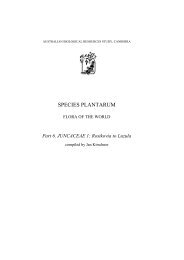Introduction - Species Plantarum Programme
Introduction - Species Plantarum Programme
Introduction - Species Plantarum Programme
Create successful ePaper yourself
Turn your PDF publications into a flip-book with our unique Google optimized e-Paper software.
The need for the Project<br />
2<br />
SPECIES PLANTARUM — FLORA OF THE WORLD (1999)<br />
Many attempts have been made to write a Flora of the World at species level. The most<br />
recent fully successful author was C.Linnaeus, <strong>Species</strong> <strong>Plantarum</strong> (1753), and the various<br />
workers who produced supplements and new editions of that work in the years to 1833.<br />
In the 19th century and early 20th century other attempts to write a complete Flora of the<br />
World met with varying degrees of success. Those who went closest were A. P. de Candolle<br />
& A. de Candolle, Prodromus Systematis Naturalis Regni Vegetabilis (1824–1873), and<br />
H.G.A. Engler and coauthors, Das Pflanzenreich (1900–1953).<br />
The chances of completing such a task are therefore slim, judged on historical precedent.<br />
Even with the strength of the French and German botanical world behind them, and with<br />
their undoubted mastery of the subject, the de Candolles and Engler were unable to take the<br />
task to its conclusion. Why then, with a much larger flora to describe than any of our<br />
predecessors, and with the world facing a chronic shortage of taxonomists, do we have the<br />
temerity to embark on this course?<br />
The reasons are diverse. Firstly, with the world facing unprecedented stress on the natural<br />
environment, when species are becoming extinct at rates rivalling the major extinction events<br />
in geological history, there is an urgent need to record what we know of the plants of the<br />
planet in a uniform, comprehensive, yet concise way. Several hundred years of experimenting<br />
with ways of cataloguing and providing guides to plant taxa have led to the evolution of the<br />
Flora, and this genre offers the best solution to providing an easy-to-use account of the kind<br />
needed.<br />
Secondly, at the present time there are probably more regional, national and continental scale<br />
Floras being written than at any other time in history. It is true that there are major gaps in<br />
knowledge and geographical coverage between them, and that all are written to different<br />
criteria. However, some reasonably up-to-date knowledge is currently available for a large<br />
part of the world's flora, and filling the gaps is not as daunting a task as it would have been<br />
even 20 years ago.<br />
Thirdly, electronic means of communication have reduced the time needed to transport text<br />
and illustrations across the world from days or weeks to seconds. Electronic means of storing<br />
and manipulating text have greatly simplified editing and publishing. Therefore, bringing<br />
together and publishing a major serial work is much quicker and much less labour-intensive<br />
than ever before.<br />
Finally, there is a demonstrated will from botanical taxonomists from around the world to<br />
make such a Flora a reality, and if this can be sustained and augmented, then the project<br />
certainly looks possible.<br />
All of those involved intend that the <strong>Species</strong> <strong>Plantarum</strong> — Flora of the World will be carried<br />
through to completion, although this will clearly take many years. However, in a project such<br />
as this, benefits accrue almost from the beginning. Families or other large groups published<br />
will have uniform world-wide descriptions and keys available. Taxonomists will be<br />
encouraged to raise their sights from regional or national revisions to global ones, either<br />
alone or in cooperation with others. Finally, and perhaps most importantly, taxonomy will be<br />
seen to be relevant, indeed crucial, to other international efforts in biological diversity<br />
conservation, including those flowing from the Convention on Biological Diversity.<br />
As our task begins, <strong>Species</strong> <strong>Plantarum</strong> is a largely voluntary project. It is hoped that with the<br />
appearance of the first few parts it will attract additional support from the world's<br />
taxonomists. Offers to provide manuscripts are particularly solicited. Assistance (financial or<br />
in kind) with the task of editing, refereeing and publishing the work will also be needed.












